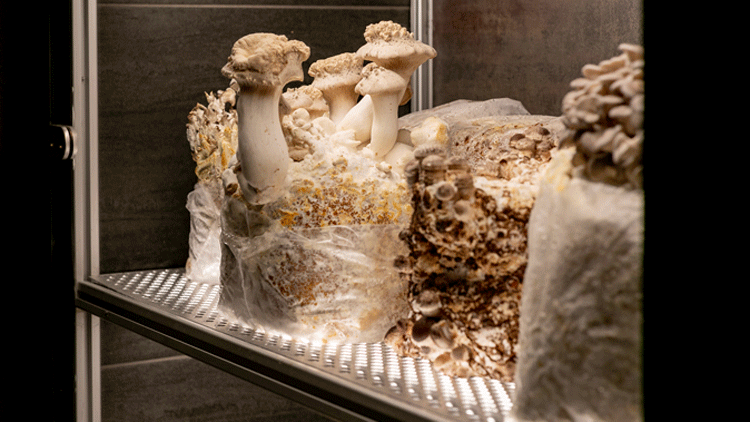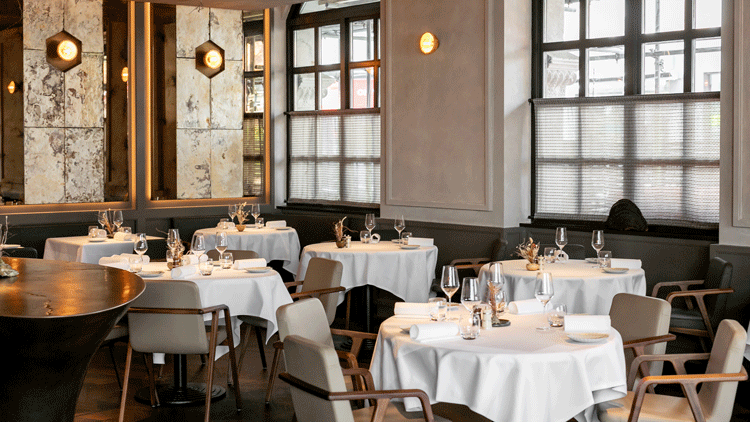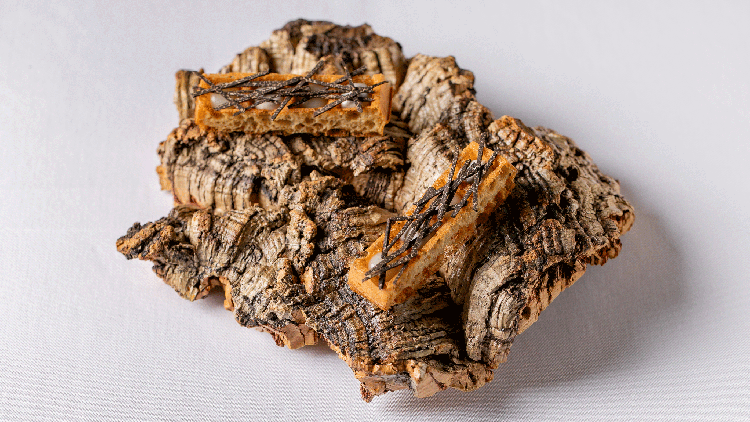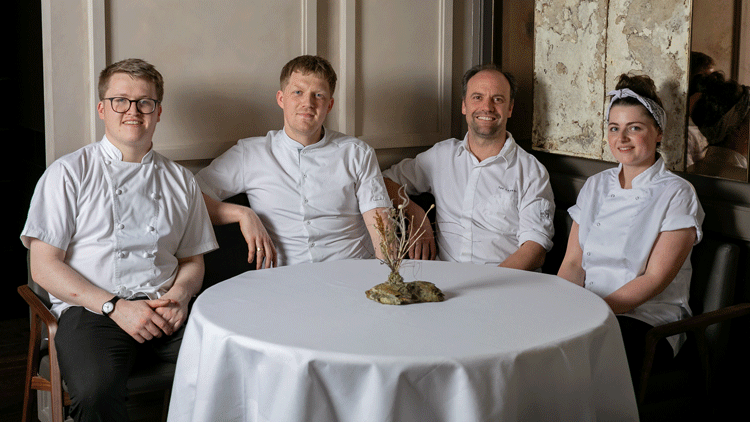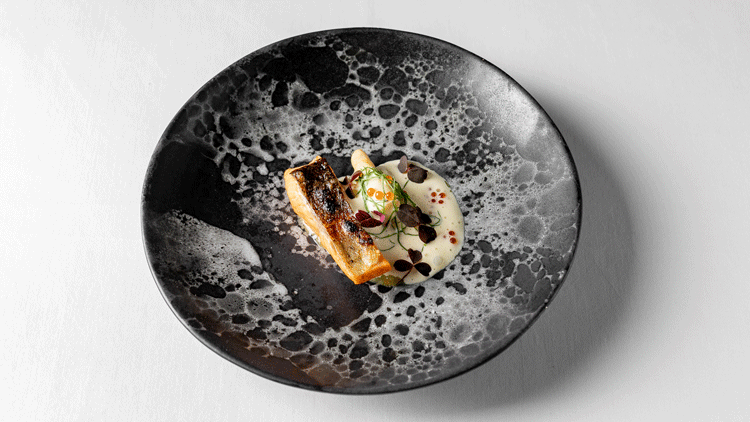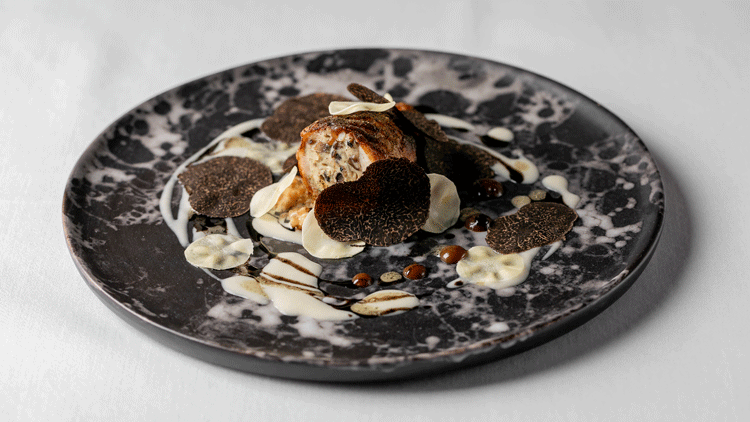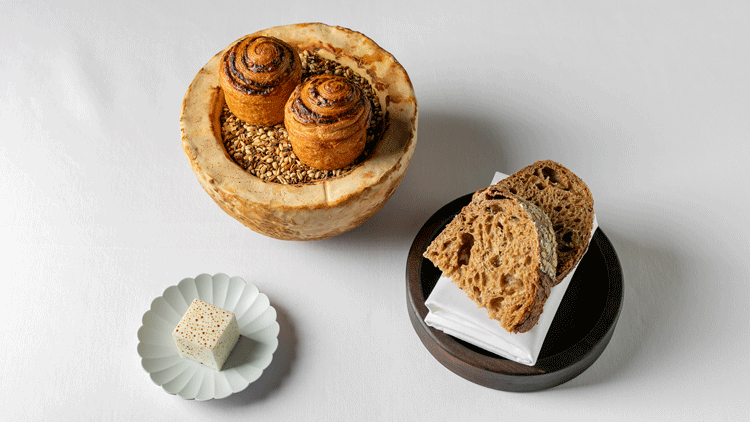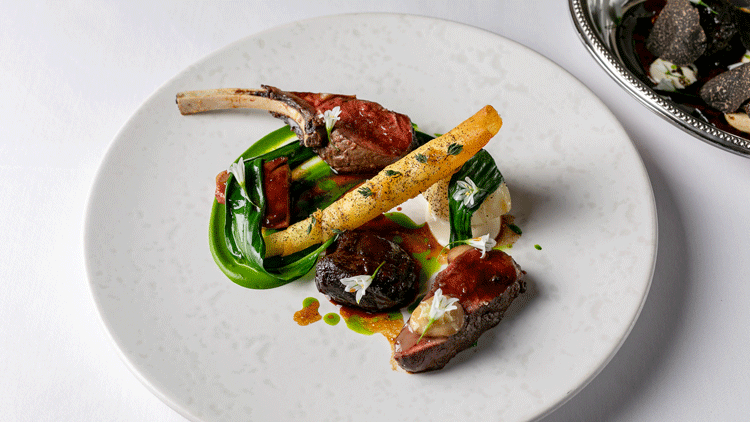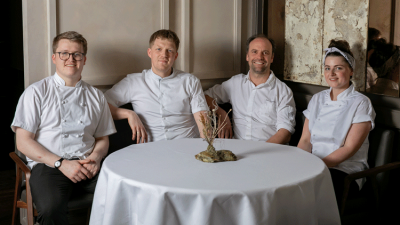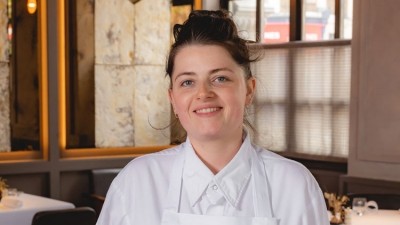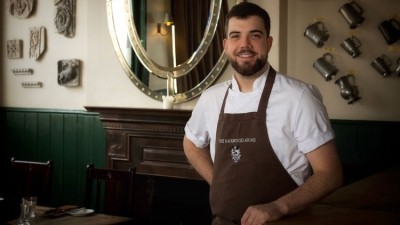Leading from the front: Brett Graham on bringing back The Ledbury
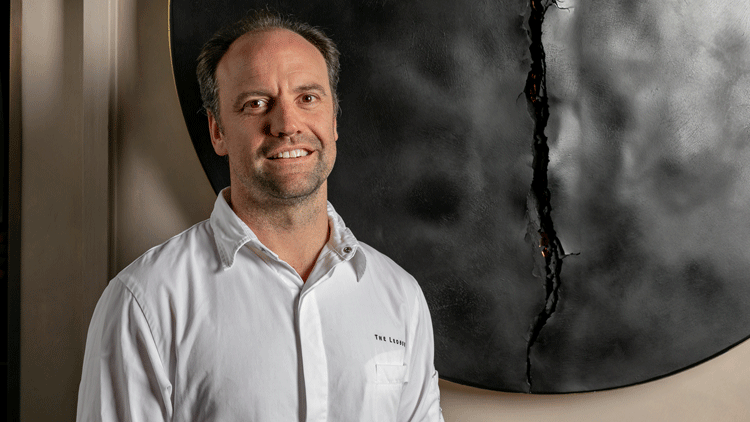
Brett Graham’s latest culinary obsession is mushrooms. Considering some of the chef’s other produce-related ‘hobbies’ – not least deerstalking – have spiralled to the extent that entirely new businesses have had to be created, then who knows where his foray into mycology will eventually take him.
True to form, he is taking things into his own hands, opting to grow the fungi himself in a large moisture-controlled cabinet supplied by Bristol Fungarium guests can inspect en route to The Ledbury’s subterranean loos.
There are lion’s manes, grey oysters, shiitakes and a Japanese variety used for making tea that resembles a huddle of tiny alien creatures. Every now and then, a fine haze of water is automatically released onto his new charges.
“I’m trying to keep the humidity around 90%. But I’m an amateur really, there’s a lot to learn,” says the Aussie-born chef, although judging by the look of his current crop, he already appears to have mushroom farming sussed.
“Assuming we get the rotation right there’s one for every guest. If people are interested, we let them choose their own and roast it for them.”
Spore taste: Graham's mushroom cabinet
Back in business
And just like that, The Ledbury is back. To the dismay of many, Graham wound the Notting Hill restaurant up in the summer of 2020 citing concerns about social distancing and a lack of international visitors to London. It was a big deal: prior to its closure The Ledbury held two Michelin stars and was a regular on BigHospitality’s list of the top 100 places to eat in the UK – indeed, it topped it no less than four times – and the restaurant even appeared on The World’s 50 Best Restaurants list.
He has used this hiatus of nearly two years to completely refit the restaurant and rethink some aspects of its operation, although its overall ethos remains unchanged.
“Though in many ways this is a continuation of what has come before I see this as the start of a new journey for us,” says Graham, who co-owns the restaurant with Phil Howard and Nigel Platts-Martin. “The old The Ledbury is no more, and we have a new sense of direction and purpose.”
That said, many facets of the old The Ledbury remain. Reimagined by Rose Murray from These White Walls, the dining room has retained much of the same layout save for a beautiful central service table made from resin and precious metals designed by Based Upon (the London-based artist also created a number of other pieces for the restaurant around the theme of cracks and fissures), but the overall look is more moody, more modern and more in step with the restaurant’s level of ambition.
Notting Hill chic: The Ledbury's new dining room
Setting the record straight
Graham is famously publicity shy and rarely speaks to the press. Rumours filled the vacuum in the run up to The Ledbury’s reopening, with reports of the restaurant planning to return as a brasserie and another story that predicted Graham would take a step back from the kitchen while simultaneously pushing for three Michelin stars.
“I have not spoken to anyone. It’s completely made up. How can you switch from cooking every day to being an owner while trying to get three stars? It doesn’t make any sense,” says Graham.
He won’t be drawn on whether Michelin is on his mind – The Ledbury has long been tipped for a third star – but he’s definitely pushing for something. Graham’s approach to his craft has always been intense, but he now seems more determined than ever to elevate all aspects of the experience. As such, the restaurant has gone from 14 services a week to offering dinner Wednesday to Sunday and lunch on Friday and Saturday. It’s also gone tasting menu-only, although a la carte may well return at some point.
Pushing the experience to even greater heights has not resulted in much of a price increase, however, with the menu rising from £165 to £185 (in real terms this is a decrease given the steep rise in costs that restaurants have seen over the last few years). The tasting menu’s format and length has not changed dramatically either, with meals at The Ledbury still running to around eight courses.
Top of the tree: sourdough waffles topped with Jerusalem artichokes and black truffle
Back with a bang
While some of The Ledbury’s back catalogue of dishes might come back over time or be dusted off for regulars, the current tasting menu offered is made up exclusively of new dishes. “There were a few dishes we were known for,” he says. “Perhaps some of them were on the menu a bit too long.
“It’s hard coming up with new dishes. Collectively the trade is getting better and better and more precise in its approach. There’s also a lot of information flowing around now. The creative process is tough.”
The Ledbury’s new menu would suggest that Graham is far from scraping the barrel creatively speaking, however, with the current menu kicking off with snacks including sourdough waffles topped with Jerusalem artichokes and black truffle before moving on to the likes of Cornish crab with cultured cream and frozen citrus; warm hen’s egg with brassicas, pig’s trotter and truffle; mushrooms from the cabinet with potato, yeast and rosemary; Japanese Sika hind with wild garlic, baked celeriac and smoked bone marrow; and verjus meringue with clementine leaf and olive oil.
While the menu showcases plenty of new ideas, Graham’s produce-led cooking remains highly distinctive. To those familiar with the restaurant everything on the menu will feel very ‘The Ledbury’. Yet things are more focused now – perhaps even a bit more serious – with the plating in particular having been sharpened up.
This is down in part to the appointment of former Kitchen Table head chef Thomas Spenceley as head chef. Given Graham’s hands on nature, the kitchen team here is as formidable as it’s ever been, boosted considerably by the return of The Ledbury alumni April Lily Partridge and Harry Corder as sous chefs. The Ledbury regulars will be pleased to note some few familiar faces in the dining room as well, not least restaurant manager Jack Settle and assistant restaurant manager Jeremy Harvey.
The Ledbury's senior kitchen team: Harry Corder, Thomas Spenceley, Brett Graham and April Lily Partridge
Going the extra mile
While Graham’s cooking is sublime, it’s never just been about the food at The Ledbury. Part of the reason for the restaurant’s success is its unusually warm and flexible service style. When it launched in 2005 Graham was too focused on the kitchen to have any input into front of house, but a year or so in he started to pay more attention to what was going on upstairs in the dining room.
“In some cases [staff] weren’t engaging their brains. There was a robotic approach to service,” he recalls. “It was quite French and stiff. I started noticing things that could be easily improved, for example opening the front door for people, meeting people from their taxi with an umbrella if it’s raining and inviting people to come and have a look at the kitchen if they showed a strong interest in the food.”
Striving to give people a reason to come back yielded immediate results, with customers regularly rebooking as they left. Central to Graham’s approach to service is empowering his dining room team to go off script in order to provide guests with a memorable experience.
“If they want to put a free glass of champagne or an extra course through, I don’t question it. They are our ambassadors, and they are in the dining room so have a better sense of what our guests will like than me. But we don’t research our guests in advance or eavesdrop - that’s creepy.”
Over the years, this free-form take on high-end restaurant service has seen the kitchen cook takes on its customers’ favourite dishes, encourage an 11-year-old considering a career in the kitchen to plate up his parent’s main courses, and even secure a Chelsea football programme for a customer ahead of a game.
“I’m not saying this sort of thing doesn’t happen at other restaurants, because it definitely does,” Graham continues. “But this is something that we do, and we want to develop it even more.”
Big in Japan: ikejime trout with roe hollandaise
Getting back in the Ladbroke groove
For 15 years The Ledbury operated seven days a week closing only for Notting Hill Carnival and for three days over Christmas and New Year. Pushing the reset button has allowed Graham to reshape the business to give himself and his staff a better work-life balance. Key to this is – of course – that the restaurant is now doing half the number of services it previously was.
“I’m not sure why we did that,” says Graham, of the restaurant’s early days. “Actually, I do know why. I felt a huge sense of responsibility to make the business work. The first few years were extremely tough.”
As part of this new approach, The Ledbury is striving to fill its tables earlier by opening at 6pm and won’t take order later than 9.15pm, allowing staff to get out earlier. It also now staggers its finishes to allow some members of the team to get out well before service ends and has set things up in such a way that team members can come in much later some days.
Very unusually, Graham is now paying his team by the hour with people clocking in and out. “The salary model of people never knowing how many hours they are doing is old-fashioned,” he says. “In my opinion by the hour is the only way to do it now.”
Another big benefit of having fewer services is that the same team is in the kitchen pretty much all the time. “This has allowed us to hit our groove much quicker,” Graham explains. “Thomas [Spenceley] is here with me every day, whereas before we would have gone days without seeing each other.”
Truffle shuffle: stuffed chicken wing
Plunging back in
Even before the pandemic, there were rumours circulating that Graham was approaching the point of burning out. While he denies this, he does admit to being a bit exhausted by it all at times.
“A seven-day operation and two young children at home was tough,” he admits. “I was finding it hard to get enough sleep. The Ledbury is physically demanding. I’m an old bloke now but I remain very much part of the team, I don’t know any other way. But if the pandemic hadn’t happened, we would have just kept going.”
With that in mind, how does it feel to be plunged back into the restaurant’s tightly proportioned basement kitchen? “I feel the same way about it as I think a lot of people in the trade do. It’s hard saying goodbye to my wife and children having been around a lot more than usual over the last few years.”
“And it’s difficult to get back on the treadmill, there’s no way to do it gently,” the 42-year-old continues. “You’re thrown back into it. I think that’s tougher for younger people than for people like me who have been in the game for a long time. But what has changed recently is that people are much more open to talking about these issues, which is good.”
The Ledbury’s closure did not result in Graham having a complete break with the professional kitchen, however, with the chef able to dedicate more time to his Michelin-starred Fulham gastropub The Harwood Arms, which he co-owns with fellow game obsessive chef Mike Robinson. He spent much of lockdown and reopening tweaking the offer with former The Ledbury head chef and now Harwood Arms head chef Jake Leach, which included an overhaul of the interior (Graham’s wife oversaw the redesign), creating new dishes and further refining the pub’s already superlative venison scotch egg.
Using their loaves: The Ledbury's bread course
Game changer
The hiatus has also allowed Graham to significantly expand his livestock operation. Graham has been obsessed with venison since he first donned hunting garb and picked up rifle.
He opened his first two deer parks - Oxfordshire’s Aynhoe Park and Northamptonshire Boughton House - about five years ago but over lockdown things stepped up a gear. Graham is now involved in several other parks as well as being a key supplier of both park venison and wild venison to the top end of the restaurant and pub market via his Capability Graham company, which supplies chefs via butchers including Lake District Farmers, Phillip Warren and HG Walter.
Since the current season began last August Graham and his deer manager and culling specialist Alex Nielson have produced an impressive 1,250 carcasses.
Graham’s species include White Deer, Fallow Deer and Japanese Sika, allowing him to source deer at most times of the year outside of the summer months. Everything is shot to order, so the animals never see the inside of an abattoir. Instead, when the time is right, they are shot, hung in the fur and finally skinned before being stamped by a vet.
“We only deliver whole as that’s the only way we can guarantee quality. That means we never freeze anything. We feed our park deer during the winter, but they pretty much just live as they live. We barely have anything to do with them in the warmer months when they’re looking after their young. We just manage the grass, which is ultimately their food.”
Graham’s countryside antics now extend well beyond deer. He is now working with a number of artisanal farmers to re-evaluate the supply chain with a focus on unlocking value for producers while simultaneously getting great ingredients into ambitious kitchens. His role is probably best described as a very hands-on consultant. Graham likes to get his boots muddy, so to speak.
One of several initiatives concerned with making better use of high-quality animals that are no longer useful is a project with the Cornwall-based Ria Warren - sister of Ian Warren of Phillip Warren fame - to bring on pure bred Jersey cows whose careers as milkers have ended. The pair – who feed the animals on a mainly silage-based diet – have been blown away by the quality, with the beef currently on the menu at Ikoyi, Moor Hall and The Ledbury itself. Graham has also experimented with using ex-laying ducks to make charcuterie.
A hallmark of his approach to husbandry is a complete re-evaluation of what the animals eat. For example, his deer enjoy all sorts of high-quality produce, including grasses and herbs that Graham seeded himself and bran produced by DJ-turned-regenerative-farmer Andy Cato (who also suppliers some of the flour for The Ledbury’s bread).
Yet nowhere is this approach more evident than Graham’s pig project. In terms of scale, it’s second only to his venison operation, with the 220-strong herd currently chomping their way through 8-10 tonnes of food per month.
“Nearly all pigs reared in this country are fed on soya produced on the other side of the world, namely Brazil,” he says. “Soya is a great protein. It’s incredibly nutritious and the animals love eating it. But there are alternatives that are grown here and in Europe, including rapeseed, linseed, sunflower seed and spent grain.”
Graham worked with Mark Hayward of Suffolk’s Dingley Dell to cross Iberian pigs with Duroc pigs, which also have a high intramuscular fat content. It’s early days but the project – which is led by Herefordshire-based farmer Wendy Scudamore – has proved that soya is not essential for those looking to produce beautifully marbled pork. The racks and bellies are likely to make their way onto The Ledbury’s menu soon and the legs and shoulders already being used to create top quality air-dried hams in partnership with Rare and Pasture head charcutier Graham Waddington.
“It’s a collaborative approach. I find the right people and get them to work together. I’m not saying that I know how to change the world. I really don’t. We’re trying to help small scale producers survive in an increasingly challenging market. The collapse of Farmdrop (an online grocer focus working with local farmers, fishermen, and growers) was very bad for young producers that were focused on quality, and it coincided with major fluctuations in demand due to Omicron.”
Graham believes chefs and restaurants could do more to help smaller producers. “Restaurants have cashflow challenges, but we get paid on the night by our guests. Farmers must tie up huge amounts of cash in livestock to be able to fulfil future orders. The least we can do is pay promptly.”
He also thinks chefs should try and be more flexible. “When you’re dealing with top-quality producers it’s unrealistic to demand that every cut is the same size. In some cases, chefs are putting constraints on good farmers. I would like to encourage more chefs to work with farmers in a more collaborative way.”
Game on: venison hind with wild garlic, baked celeriac and smoked bone marrow
Looking after vegetarians and vegans
Despite Graham’s strong interest in animal husbandry, he is clear that The Ledbury is not a meat-focused restaurant. Long before it was fashionable the kitchen was known for handling its greens with the care and dexterity usually reserved for animal proteins, a case in point being a dish of root vegetables cooked individually in either salt or clay depending on moisture levels (when the time is right it is likely to return, with Graham in the process of developing a new technique that sees the vegetables roasted in Cato’s bran).
Unlike an increasing number of his peers, Graham embraces dietary requirements of all types, not least vegetarians and vegans. “It’s hospitality, isn’t it?” he shrugs. “It can be difficult to manage but in my view it’s just something we need to do.”
Though nobody in the industry would have expected this famously hard-working Aussie to phone in the relaunch of his flagship, the degree to which he has thrown himself back into things is nonetheless impressive. Though he’s careful not come across as boastful, The Ledbury is busier than ever in its new incarnation (five weeks’ worth of covers were booked in a matter of hours as the restaurant reopened its bookings).
“It’s great to be back. I don’t do social media or anything like that, so I’ve been a bit disconnected from things. The reopening has been emotional for me, and I think a lot of our guests too. My faith in hospitality has been restored.”
